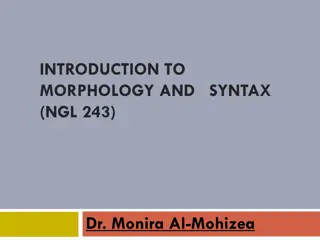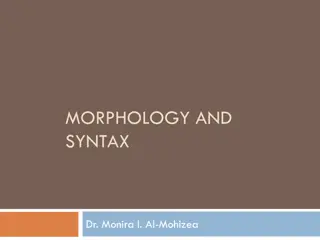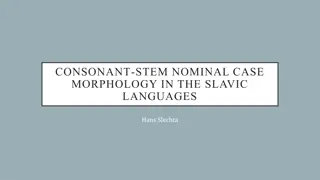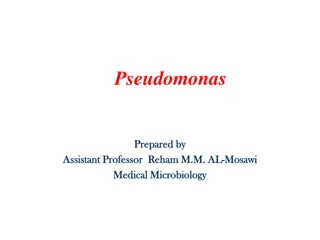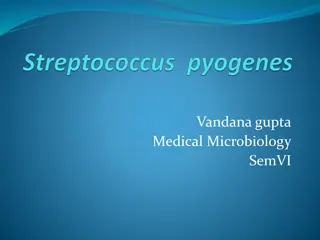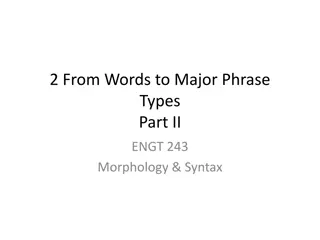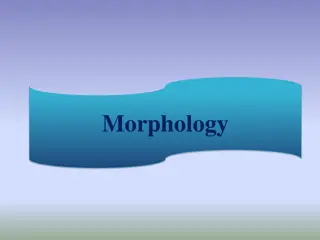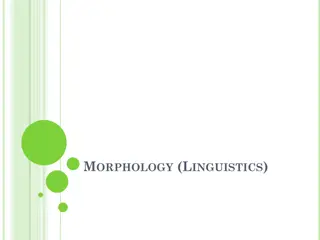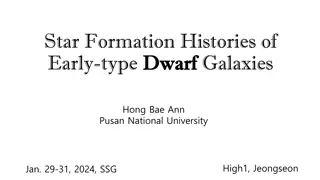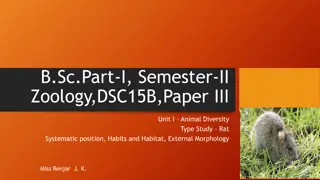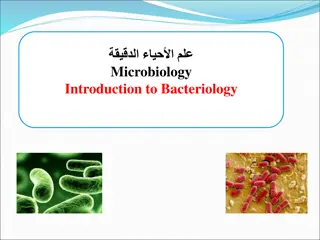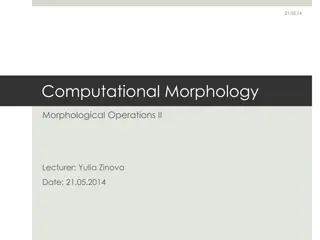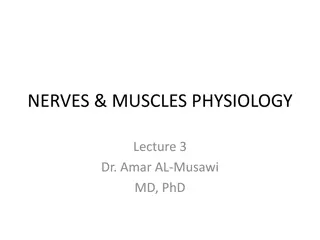Overview of Myxoviruses: Classification, Morphology, and Orthomyxoviridae
Myxoviruses are a group of viruses that bind to mucin receptors on red blood cells, causing hemagglutination. They are classified into orthomyxoviridae and paramyxoviridae, with influenza viruses being major pathogens. Influenza viruses consist of three genera and have distinct morphological features and RNA segments coding for specific proteins essential for viral replication. Understanding the classification and morphology of myxoviruses is crucial for studying their pathogenicity and developing treatment strategies.
Uploaded on Sep 29, 2024 | 0 Views
Download Presentation

Please find below an Image/Link to download the presentation.
The content on the website is provided AS IS for your information and personal use only. It may not be sold, licensed, or shared on other websites without obtaining consent from the author. Download presentation by click this link. If you encounter any issues during the download, it is possible that the publisher has removed the file from their server.
E N D
Presentation Transcript
Myxoviruses Myxoviruses Group of viruses that bind to mucin receptors on the surface of RBCs (myxoin Greek meaning mucin ). Mucin receptors - Clumping of RBCs together to cause hemagglutination.
CLASSIFICATION CLASSIFICATION- - Properties Orthomyxoviridae 80-120nm Spherical; Rarelyfilamentous Negative sense ssRNA, Segmented; eight pieces Seen Seen Nucleus Paramyxoviridae 100-300 nm Pleomorphic; Size Shape Nucleic acid Negative sense ssRNA Un-segmented; single piece Not seen Not seen Cytoplasm Parainfluenza virus Mumps virus Measles virus Respiratory syncytial virus Metapneumovirus Genetic recombination Antigenic variation Site for RNA Replication Important human pathogens Influenza virus
ORTHOMYXOVIRIDAE ORTHOMYXOVIRIDAE Influenza viruses are the members of Orthomyxoviridae family. Major causes of morbidity and mortality and have been responsible for several epidemics and pandemics of respiratory diseases in the last two centuries.
Influenza viruses consist of thee genera- Influenza A, B, and C. Spherical and 80 120 nm in size Helical nucleocapsid(9nm),surrounded by an envelope Viral RNA comprises of multiple segments of negative sense single stranded RNA. Each segment codes for a specific viral protein having a specific function. o Influenza A & B contain eight segments of RNA o Influenza C contains seven segments of RNA. The segment coding for neuraminidase is absent.
Morphology Morphology Site of RNA replication- nucleus Viral proteins RNA segments Segment-6 Coded Protein(s) NA Function of proteins Replaces HA from RBCs to cause elution (reversal of hemagglutination) (neuraminid ase) M1&M2 RNA segments Segment-1 Segment-2 Segment-3 Segment-4 Coded Protein(s) Function of proteins PB2 RNA Transcription and replication PB1 PA HA Binds to receptors of RBC to cause hemagglutination. M1-forms a shell underneath the envelope Segment-7 M2-formsion channels NS1-is interferon antagonist &inhibits pre- mRNA splicing Segment-8 NS1&NS2 (hemagglutinin) NP Associates with RNA to form helical nucleocapsid Segment-5 NS2-is nuclear export factor (nucleoprotein)
Morphology (cont..) Morphology (cont..) Envelope is lipoprotein in nature. o Lipid part is derived from the host cell membrane. o Proteins or the peplomers arevirus coded,10nm long glycoproteins that are inserted into the lipid envelope. o Two peplomers are present- Hemagglutinin (HA) Neuraminidase (NA)
Morphology (cont..) Morphology (cont..) Hemagglutinin (HA): o Triangular shaped peplomer, binds to mucin or sialic acid receptors on RBCs, resulting in clumping of RBCs to cause hemagglutination. o Binds to the receptors on respiratory epithelial cells, thus facilitating viral entry.
Morphology (cont..) Morphology (cont..) Neuraminidase (NA): Mushroom-shaped peplomer, present in fewer number than HA. Sialidase enzyme that degrades the sialic acid receptors on RBCs; thus helps in- o Displaces HA from RBCs resulting in reversal of hemagglutination called elution. o Facilitates release of virus particles from infected cell surfaces during budding process by preventing self-aggregation of virions to the host cells. o NA helps the virus to pass through the mucin layer in the respiratory tract to reach the target epithelial cells.
Antigenic Antigenic subtypes and subtypes and Nomenclature Nomenclature Three Genera-Based on RNP and M proteins, influenza viruses are divided into four genera: A, B and C and D Subtypes- Based on HA and NA antigens, Influenza A has distinct 18 H subtypes (H1 to H18) and 11 N subtypes (N1- N11), o Most of the subtypes infect animals and birds, rarely human major epidemics and pandemics. o Example- Six HA (H1, H2, H3, H5, H7 & H9) and two NA (N1&N2) subtypes have been recovered from humans. Influenza B and C viruses though have subtypes; but are not designated. Influenza D virus primarily infects cattle and are not pathogenic to humans.
Antigenic Antigenic subtypes and subtypes and Nomenclature Nomenclature Standard nomenclature system: Any influenza isolates should be designated based on the following information: Influenza Type/ host (indicated only for non-human origin)/ geographic origin/strain number/year of isolation/(HA NA subtype). Examples: o Human strain- Influenza A/Hong Kong/03/1968(H3N2) o Nonhuman strain- Influenza A/swine/Iowa/15/1930(H1N1)
Antigenic variation Antigenic variation Antigenic variation is the unique property of Influenza viruses, which is due to the result of antigenic changes occurring in HA and NA peplomers. o Antigenic drift o Antigenic shift
Antigenic drift Antigenic drift Minor change occurring due to point mutations in the HA/NA gene. Results in alteration of amino acid sequence of the antigenic sites on HA/NA, such that virus can escape recognition by the host's immune system. New variant must sustain two or more mutations to become epidemiologically significant. Seen in both Influenza virus type-A&B Results in outbreaks and minor periodic epidemics Antigenic drift occurs more frequently every 2-3 years.
Antigenic shift Antigenic shift Abrupt, major drastic, discontinuous variation in the sequence of a viral surface protein (HA/NA) Occurs due to genetic re-assortment between genomes of two or more influenza viruses infecting the same host cells,resulting in a new virus strain, unrelated antigenically to the predecessor strains. Occurs only in Influenza A virus Results in pandemics and major epidemics- e.g. H1N1 pandemics of 2009. Antigenic shift occurs less frequently every 10-20 years.
Pathogenesis Pathogenesis Pathogenesis Transmission Explanation Via aerosols Small-particle aerosols (<10 m) are more efficient in the transmission. Target cell entry Multiply locally Viral HA attaches to specific sialic acid receptors on the host cell surface Ciliated columnar epithelial cells are most commonly infected. Virus replicates in the infected cells and infectious daughter virions spread to the adjacent cells.
Pathogenesis Pathogenesis Pathogenesis Explanation Spread Very rarely, virus spreads to the lower respiratory tract or spills over blood stream to involve extra pulmonary sites. Cellular destruction and desquamation of superficial mucosa of the respiratory tract Edema and mononuclear cell infiltrations occur at local site leading to cytokine influx, which accounts for local symptoms. Local damage predisposes to secondary bacterial invasion. Local damage
Host Host immune immune response response Humoral immunity - predominant Type and subtype-specific and long lasting. Antibodies against HA and NA protective Antibodies to HA - prevent initiation of infection by inhibiting viral entry Antibodies to NA decrease the severity of the disease and prevent the transmission of virus to contacts Antibodies against other viral proteins are not protective.
Host Host immune immune response response Antibodies against the ribonucleoprotein - useful in typing viral isolates as influenza A or B or C. All the three types of influenza viruses (i.e. A,B &C) are antigenically unrelated and there is no cross-protection. Immunity incomplete - reinfection with the same virus can occur.
Clinical Clinical Manifestations Manifestations Incubation period - 18-72 hours Uncomplicated Influenza (Flu syndrome): o Asymptomatic or develop minor upper respiratory symptoms such chills, headache, and dry cough, followed by high grade fever, myalgia and anorexia. oSelf-limiting condition.
Complications Complications Pneumonia: Secondary bacterial pneumonia - most common Common agents are staphylococci, pneumococci and Haemophilus influenzae. Primary Influenza pneumonia is rare but leads to more severe complication. Combined viral-bacterial pneumonia- It is three times more common than primary influenza pneumonia, most common co-infection being S.aureus.
Clinical Clinical Manifestations Manifestations Other pulmonary complications: oWorsening of COPD oExacerbation of chronic bronchitis and asthma. Reye's syndrome
Clinical Clinical Manifestations Manifestations The following are at increased risk of complications: o Age- children <2yrs& old age (>65yrs) o Pregnancy o Underlying chronic lung, cardiac, renal, hepatic, and CNS conditions o Low immunity(HIV infected people) o Children have high risk of developing croup, sinusitis, otitis media, high- grade fever, and diarrhoea.
Epidemiology Epidemiology Incidence: 3 5 million cases of severe illness and 2.5 5 lakhs of deaths occur worldwide. Seasonality: Common during winters. The most common seasonal flu strain varies from season to season and from place to place (e.g. H3N2 in Pondicherry in 2018) Epidemiological pattern: Depends upon the nature of antigenic variation that occurs in the influenza types.
Epidemiology Epidemiology Major influenza outbreaks: Years 1889 1890 1900 1903 1918 1919 Subtype H2N8 H3N8 H1N1a (HswN1) (Spanish flu) H1N1a (H0N1) H1N1 H2N2 (Asian flu) H3N2 (Hong Kong flu) H1N1 (Russian flu) H1N1 Extent of Outbreak Severe pandemic ?Moderate epidemic Severe pandemic 1933 1935 1946 1947 1957 1958 1968 1969 Mild epidemic Mild epidemic Severe pandemic Moderate pandemic 1977 1978b Mild pandemic 2009 2010 Pandemic
REFRENCES Text Book Of Medical Microbiology by Ananth Narayan Paniker Text Book Of Medical Microbiology by D R Arora Text Book Of Medical Microbiology by A S Sastry Text Book Of Medical Microbiology by Baweja Text Book Of Medical Microbiology by Satish Gupte








